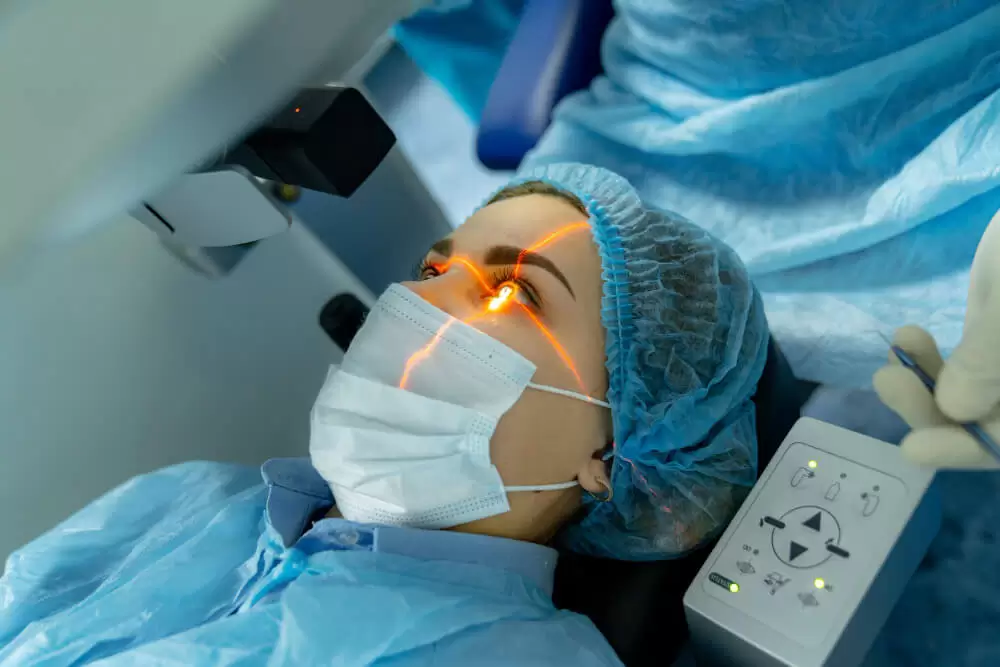
Excimer laser is a laser technology used in refractive eye surgery. This surgery treats eye diseases such as myopia (problem with far vision), hypermetropia (problem with near vision) and astigmatism (problem with both near and far vision). After laser eye surgery, there is no need to wear glasses or contact lenses.
The process of polishing and reshaping the cornea is carried out by making thousands of small laser shots with the device. The data obtained from the measurements taken before the treatment and the degree of defect to be corrected are entered into the computer of the device. The device calculates how many laser shots and how much correction will be made at which points.
The patient lies on a special bed and looks at the light. The device detects the patient's pupil and the eye tracking system is activated.
Laser application is completely painless. For this, anesthesia is given with eye drops. In very agitated and nervous patients, sedatives are used to ensure a calm and comfortable procedure. After the laser treatment is completed, there is no need to close the eyes, the patient can stand up and walk by himself, but he should not drive a car.
under 18 years of age;
Pregnant women;
Eye numbers changed during the last 1 year;
Those with dry eye syndrome;
Those with keratoconus disease;
Those with eye infections;
Diabetic patients;
Those with cataracts
More than 31 million laser eye surgeries have been performed worldwide. In the US, which has very strict regulations, more than 1 million laser surgeries are performed each year. It has FDA approval in the US and CE approval in the European Union. These operations have a history of about 35 years. Over the years, technology has evolved more and more.
In corneal diseases and refractive surgery, the knowledge, training and experience of the doctor who will perform laser eye surgery is very important for risk assessment and timely intervention of problems.
As with any type of surgery, laser refractive surgery has some risks and complications.
There is no damage to the eye when the correct surgical method is applied to a patient with a suitable eye structure. For various reasons, some complications can occur when the wrong methods are applied to the wrong eye.
If you want to have a baby after eye surgery, there are some things you should consider. Many doctors recommend waiting at least six months after LASIK surgery to get pregnant.
Burning, watery eyes and slightly blurred vision should be considered normal for 4-5 hours after the operation. The drops should be used every 1-2 hours. The next day after the examination, patients can return to their daily lives. After 1 day, you can take a bath without applying soap or shampoo to the eyes. In addition, it is necessary not to swim in the pool or the sea for 3 weeks, not to wear eye makeup for 2 weeks, to avoid rubbing and scratching the eyes.
Laser Eye Surgery is an individual treatment method. Prices may vary depending on the type of procedure to be performed and whether it is two eyes or one eye. Therefore, you can get information about the actual prices of laser eye surgery during the examination.
The 4 different methods most commonly used today are:
PRK;
LASIK;
FemtoLASIK;
No-Touch;
SMILE
The first PRK method is suitable for patients with thin corneas. Complaints such as stinging, burning, watery eyes occur within 3 days after the PRK method. However, after this period, the patient relaxes and within days the vision level reaches the pre-operative level of vision with glasses or contact lenses.
LASIK is for patients with thicker corneas. For patients with higher visual acuity, LASIK is preferred, but the weaker the eye, the thicker the cornea must be to perform LASIK. In addition, people with hypermetropia and high astigmatism may be more appropriate to choose the LASIK method if the structure of the cornea is suitable.
Excimer laser and femtosecond laser are used together in FemtoLASIK operation. When performing Lasik, the first step, cutting the flap, is done with a laser, not a microkeratome (knife). For this reason, it is also called Bladeless Lasik.
- Thanks to this device, the complications that can be seen in previously used microkeratome systems have been almost eliminated.
- Special flaps can be created for the patient's refractive error with a femtosecond laser.
- The results are more successful, especially in the treatment of hypermetropia and astigmatism.
- Corneal biomechanics are better preserved in femtosecond laser flaps.
The No-Touch laser is used for people with near or far vision problems, as well as those who have undergone cataract surgery or are at risk of retinal detachment. The No-Touch laser method is a method that has appeared in recent years and allows to treat eye numbers with a special program without touching the eyes.
It is a suitable treatment method for athletes and professionals who are at risk of exposure to shock and pressure.
SMILE laser treatment is one of the customized surface laser treatments that we generally apply to eyes with thin corneas and not very high myopia and astigmatism. This laser treatment can be applied to people whose eye structure is deemed suitable for surgery as a result of a detailed examination by a doctor.
2024-07-17
2024-02-14
2024-06-12
2024-06-13
2024-06-13
2024-06-13
2024-06-14
2024-06-14
2024-06-14
2024-06-14
2024-06-14
2024-06-14
2024-06-14
2024-07-31
2024-07-31
2024-07-31
2024-07-31
2024-08-09
2024-08-12
2024-08-28
2024-09-05
2024-09-06
2024-09-14
2024-09-19
2024-09-19
2024-10-01
2024-10-02
2024-10-07
2024-10-21
2024-10-23
2024-10-29
2024-11-12
2024-11-18
2024-11-21
2024-11-26
2024-11-28
2024-12-03
2024-12-06
2024-12-10